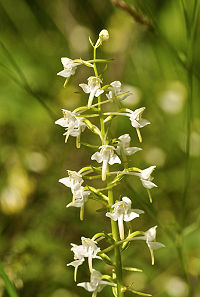Platanthera chlorantha
Greenish butterfly orchid ( Platanthera chlorantha )
The Greenish butterfly orchid ( Platanthera chlorantha ), also Greenish butterfly orchid or butterfly orchid mountain - called, is a plant belonging to the orchid family ( Orchidaceae). It occurs in Europe and in North and East Asia. The specific epithet is derived chloranta in meaning green, ergrünend from the Greek and refers to the greenish color of the flowers. The popular name mountain cuckoo flower absorbs the heaping occurrence in montane altitudes reference.
Description
The Greenish butterfly orchid grows as a deciduous, perennial herbaceous plant that can reach heights of growth of 30 to 60 centimeters. The two fleshy, oval to spindle- shaped tubers, whose ends are extended to root-like appendages, have a length of 2 to 4 centimeters and a thickness of 0.8 to 1.5 inches. The upright stems have a tubular sheath at the base. The two to five leaves branch against almost constantly on the stem base and are at a length of 10 to 20 centimeters and a width of 3 to 8 inches elliptic- spatulate shaped to wrong - lanceolate. They are narrow at the base and its tip is blunt or pointed.
The flowering period, about two weeks earlier than Platanthera bifolia, extending into Central Europe from May to August, in China from June to August. The seeds ripen from July to September. The inflorescences, pyramidiale ears, have one to four bracts and are 7-23 inches long. They consist of 9 to 32 white to greenish - white, fragrant single flowers. The bracts of the flowers are lanceolate with a length of 10 to 22 mm and have a pointed tip. The flower stalk and ovary are bent and reach a length of 12 to 18 millimeters and they are cylindrically shaped. The lower five annoying sepals are spherical - shaped heart-shaped with a length of 5 to 7 mm and a width of 5 to 6 mm to boat-shaped and form the petals a kind of hood. The lateral, oblique outgoing, three to five annoying sepals are ovate shaped with a between 7,5 and 8 mm and a width of 4 to 4.5 millimeters. The one-to three annoying petals go off at an angle and are at a length of 5 to 6 mm and a width of 2.5 to 3 millimeters nearly lanceolate - ovate in shape. The protruding hanging up, tongue -shaped flowers lip tapers toward the tip and is 8 to 13 millimeters long and about 2 mm wide. The 16 to 36 millimeters long, clavate - cylindrical spur is hanging or is just starting, sometimes it is also bent up and thickens towards the greenish tip. It towers above the ovary. The column style is strong and the stamens are striking. The elliptical pollinia are much further apart than is the case with the two-bladed butterfly orchid and splay apart down. They are usually slightly curved and let the spur entrance free.
The chromosome number is 2n = 42
Ecology
Main pollinators are moths, which the pollinia sat down on the eyes. Lured they are of a wax- like scent, the form reinforces the flowers at dusk. Over their long snout moths can reach the nectar located at the spur end.
Distribution and location
The distribution of green lichen Waldhyazinthe includes Europe, Russia, China, the Korean Peninsula and Japan. In China they are found in the provinces of Gansu, Hebei, Heilongjiang, Henan, Jilin, Liaoning, Nei Mongol, Qinghai, Shaanxi, Shandong, Shanxi, Sichuan, Xizang and Yunnan.
The Greenish butterfly orchid thrives in Europe, preferably on calcareous soil, in light deciduous and coniferous forests, like in bushes zones and forest edges, as well as lean and wet meadows. At sites in the forest interior remains mostly sterile. In China altitudes are populated 400-3300 meters. It grows mainly on slopes, meadows and forests.
System
The first description was in 1827 as Orchis chlorantha by Jakob Laurenz Custer in New Alp. 2, pp. 400 In the year 1828 led Heinrich Gottlieb Ludwig Reichenbach the way in the manual of the natural lichen plant system 2, p 1565 in the genus Platanthera. Other synonyms for Platanthera chlorantha ( Custer ) Rchb. are Gymnadenia chlorantha ( Custer ) Ambrosi and Habenaria chlorantha ( Custer ) Bab ..
Threats and conservation
The Greenish butterfly orchid is in the Red List of the Federal Republic of Germany listed as " endangered" and is specifically protected under the Federal Nature Conservation Act. As ThreaTs fertilizer entry apply to the soil and vegetation encroachment of locations such as skim lawn. Protection measures to preserve such places Entbuschung the growth or maintenance light forest edges can make a contribution for purposes of preservation.
Swell
- Xinqi Chen, Stephan W. Gale & Phillip J. Cribb: Orchidaceae. Platanthera. In: Wu Zhengyi, Peter H. Raven & Hong Deyuan (eds.): Flora of China. Orchidaceae. Volume 25, Science Press and Missouri Botanical Garden Press, Beijing and St. Louis, Platanthera chlorantha, p 107 ( this printed work is the same text online, Platanthera chlorantha - Online).
- H. Baumann, S. Künkele: The wild orchids of Europe. Frankh, 1982, ISBN 3-4400-5068-8.
- Karl Peter Buttler: orchids, the wild species and subspecies of Europe, the Near East and North Africa. Mosaik Verlag 1986, ISBN 3-5700-4403-3.
- Hans Sundermann: European and Mediterranean orchids. Bridge -Verlag, 2nd edition: 1975, ISBN 3-8710-5010-5.
- Ruprecht Duell, Herfried Kutzelnigg: Pocket Dictionary of Plants in Germany and neighboring countries. The most common central European species in the portrait. 7, revised and expanded edition. Quelle & Meyer, Wiebelsheim 2011, ISBN 978-3-494-01424-1.




.jpg)




